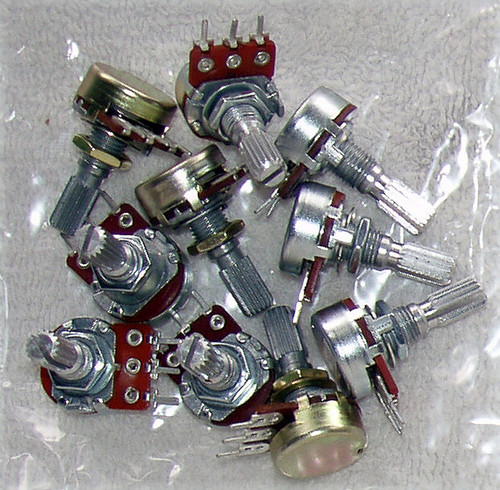HISTORY:
Sustainability is the name of the game! Anything (that has been tested and still functioning properly) should be repurposed creating saving in wasted Ee and reducing the poisoning our environment when items are buried in the earth at the local tip needlessly.
Never heard of Ee? It is a concept that creates a measurement of ALL things (not just electronics) that humans have made and the energy used in obtaining the raw material, processing the materials right through to a finished product and even should include the shipping of the item to the distributors/retailers.
If you would like to know more about Ee values, please take a look HERE
Note to be confused with Seymour Duncan products (mainly involved in the world of musical instrument electronics), this DUNCAN is a custom made, precision potentiometer with class!
Removed from some more laboratory grade research equipment I had been asked to save from the "big hole in the ground" and instantly you can tell this pot is just a bit "different" Brass top cap and two metal bands around the body held securely by 2x bolts. Side terminals are not just ordinary solder tags but "proper" terminals for solder hard wiring.
I cannot find out what happened to Duncan Electronics Inc (Costa Mesa, California) but have strong suspicions they may have been swallowed up by Bourns - the 6638 series pots from Bourns look to be EXTREMELY similar physically to this pot.
Read on for more details about this pot ...
DUNCAN ELECTRONICS (USA) - Precision Rotary Potentiometer
Custom made in USA
Type: 1200-895 Series
Value: 500 Ohm
5% track tolerance
Linearity: +/- 0.5%
I think (but not 100%) that the operational life of these is in the region of 20 million rotations (similar specs to the Bourns 6638 series)
I believe this to be a conductive plastic track (certainly not wire wound, no "bumps" can be felt while rotating and the linearity of .5% just wouldn't be feasible with a wire wound track)
Taper: Linear
Single turn BUT WITH NO STOPS i.e continuous rotation of the shaft
300 degree rotation to achieve 0 Ohm ~ 500 Ohm
At the "crossover" point where the track is no more, the reading between slider and track is infinity, meaning as you continuously rotate the shaft in the one direction, the resistance at the slider is 0 ~ 500 infinity 0 ~ 500 ad infinitum
Panel mounting (supplied with nut & washer)
Long (28.75mm), round 3.25mm (.13") diameter metal shaft (not a D shape with flat spot)
DIMENSIONS:
Body: 22.25mm diameter x 16.35mm height
Panel mounting hole required: minimum 6.1mm
Shaft length: 28.75mm
Side mounted round solder terminals
The assembly is impressive with the very nice Brass top section/thread which fits nicely into the body and two "metallic bands" keep everything in place with these bands being secured by tiny bolts. It really appears that this potentiometer was NOT machine assembled but custom hand assembled.
COSMETIC CONDITION:
USED
Clean and undamaged physically
Solder tags have been cleaned and "dags" removed
Printed in Silver ink on the Black body
1200-895 500Ohm +/-5% LIN +/-0.5%
S CCW CW (these indicate the track connections)
Duncan Electronics Inc. Costa Mesa, Calif.
TESTING:
Being a USED potentiometer, I made some measurements of the DC track resistance and also checked the linearity and taper type.
Measured track resistance is 502 Ohm
Definitely a linear track and the resistance linearity while moving the shaft postion was smooth and even, no "resistance jumping", dropouts or "backlash" noticed. I noticed that the shaft rotation is so silky smooth, I suspect there are ball bearings inside this one!
To maintain the condition of this precision potentiometer, it has now been sealed in a clear plastic packet














